Contract Law: Analyzing Legal Issues and Problem Solving
VerifiedAdded on 2022/12/23
|7
|1552
|102
Homework Assignment
AI Summary
This document presents a comprehensive solution to a contract law assignment, addressing two key legal problems. The first problem examines the validity of a verbal agreement, considering elements like intention and consideration, and analyzing the scenario of Nick and Frank. The second problem delves into misrepresentation in contract law, differentiating between fraudulent, negligent, and innocent misrepresentation, and applying these concepts to a case involving Donald and Hugh. The solution utilizes relevant case law, such as Hospital Products Ltd v United States Surgical Corp, Bisset v Wilkinson, Esso Petroleum v Mardon, and Edgington v Fitzmaurice, to support the analysis and reach logical conclusions regarding the parties' rights and potential remedies. The document provides a detailed breakdown of the legal issues, the application of legal principles to the facts, and the likely outcomes of each scenario, offering a valuable resource for students studying contract law.
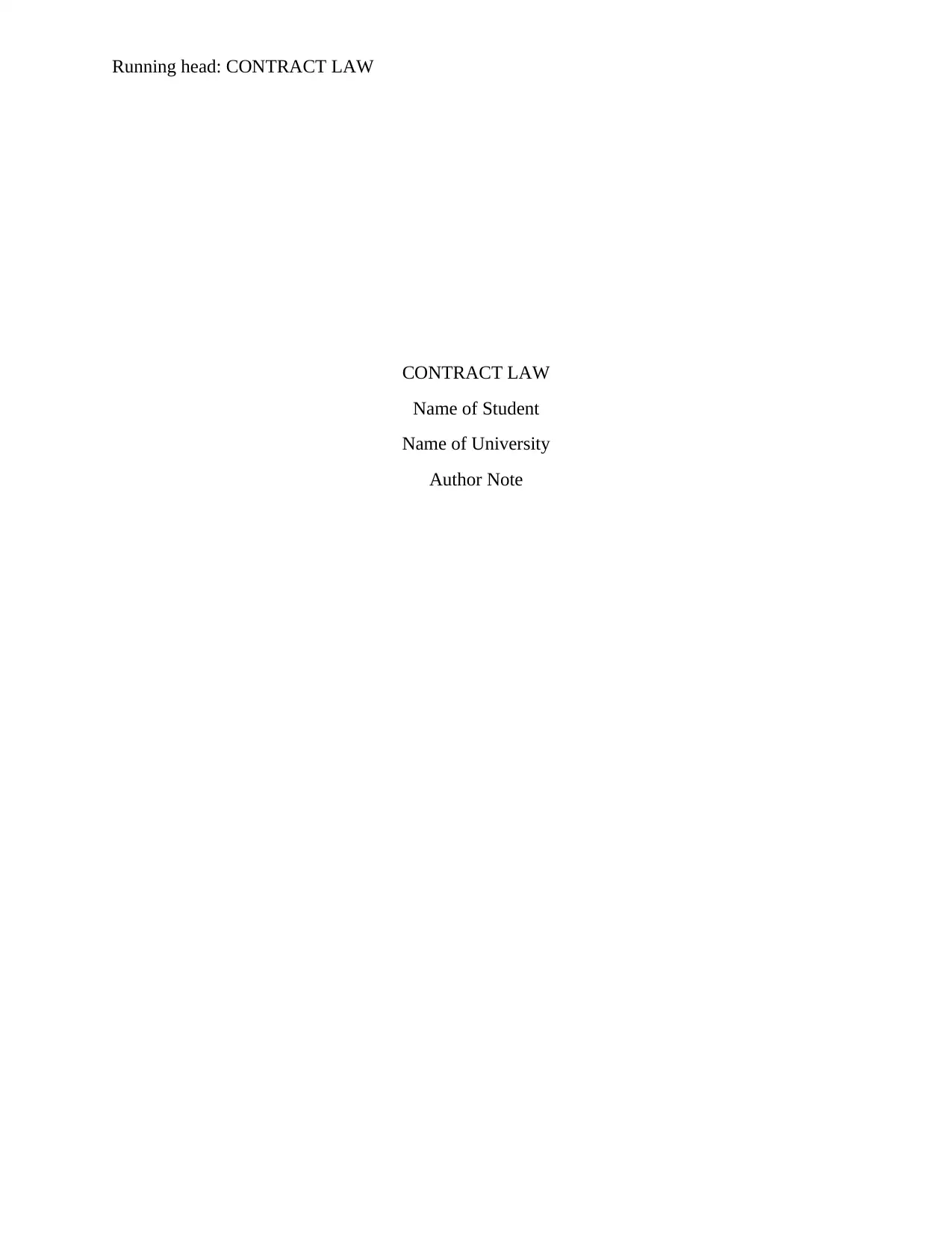
Running head: CONTRACT LAW
CONTRACT LAW
Name of Student
Name of University
Author Note
CONTRACT LAW
Name of Student
Name of University
Author Note
Secure Best Marks with AI Grader
Need help grading? Try our AI Grader for instant feedback on your assignments.
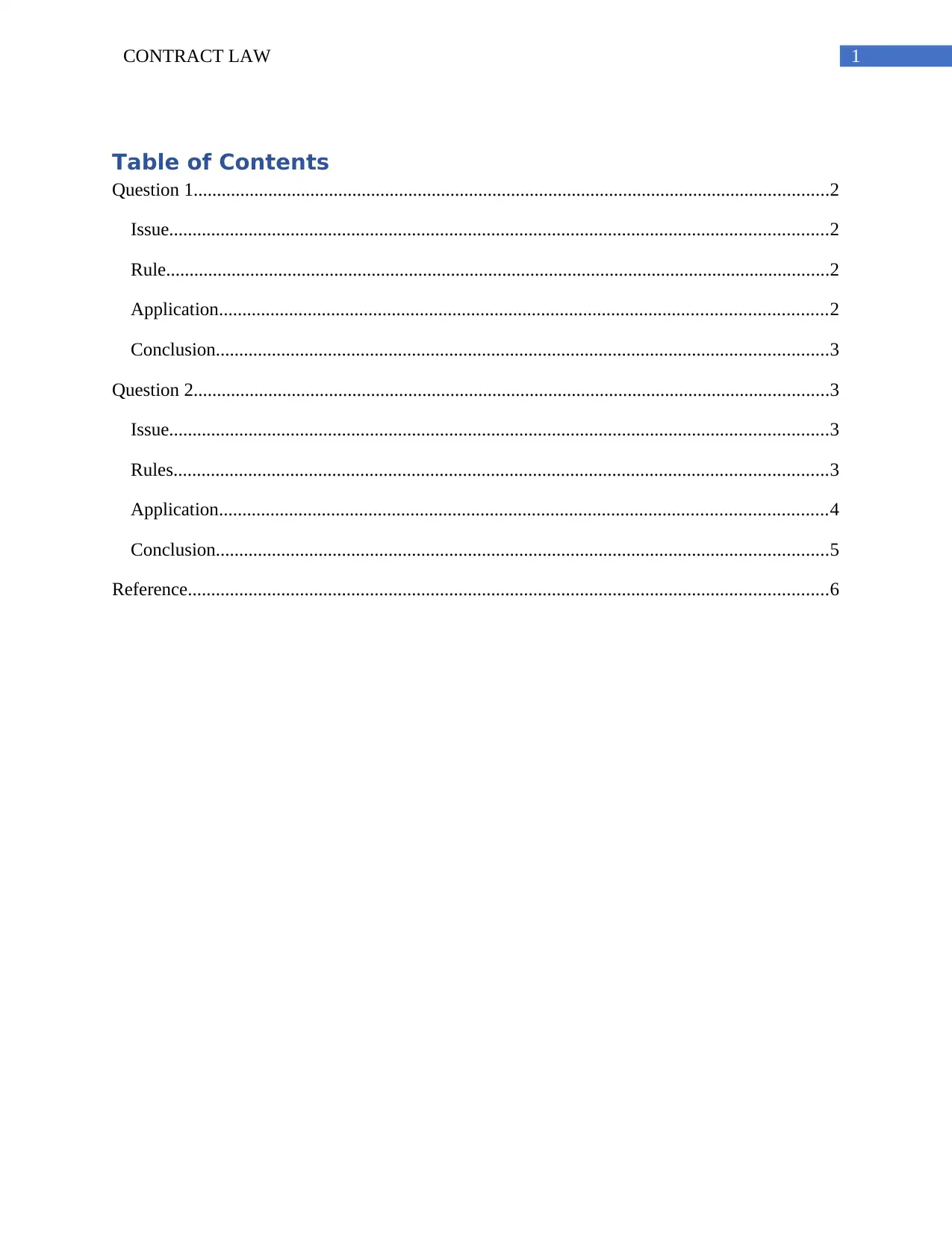
1CONTRACT LAW
Table of Contents
Question 1........................................................................................................................................2
Issue.............................................................................................................................................2
Rule..............................................................................................................................................2
Application..................................................................................................................................2
Conclusion...................................................................................................................................3
Question 2........................................................................................................................................3
Issue.............................................................................................................................................3
Rules............................................................................................................................................3
Application..................................................................................................................................4
Conclusion...................................................................................................................................5
Reference.........................................................................................................................................6
Table of Contents
Question 1........................................................................................................................................2
Issue.............................................................................................................................................2
Rule..............................................................................................................................................2
Application..................................................................................................................................2
Conclusion...................................................................................................................................3
Question 2........................................................................................................................................3
Issue.............................................................................................................................................3
Rules............................................................................................................................................3
Application..................................................................................................................................4
Conclusion...................................................................................................................................5
Reference.........................................................................................................................................6
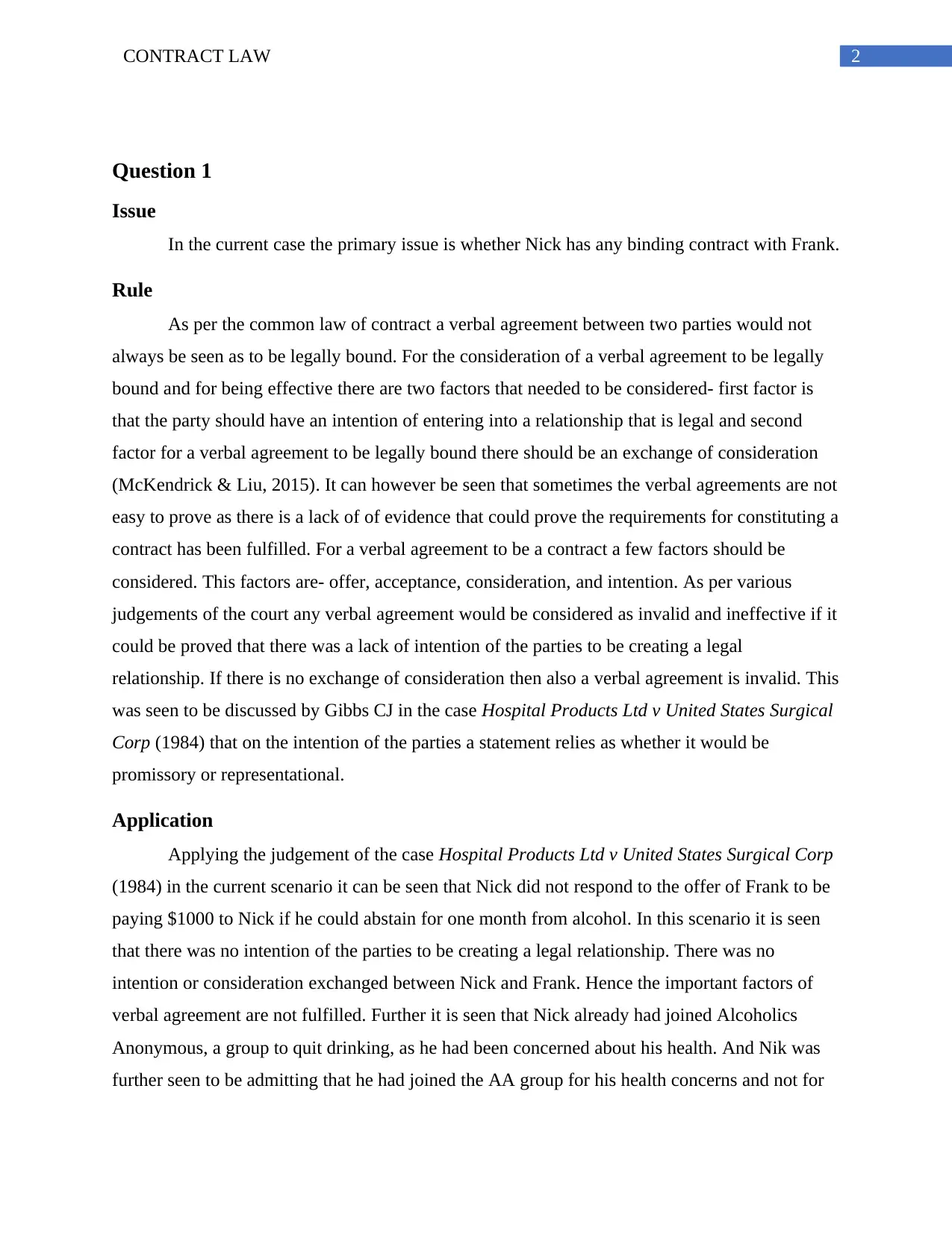
2CONTRACT LAW
Question 1
Issue
In the current case the primary issue is whether Nick has any binding contract with Frank.
Rule
As per the common law of contract a verbal agreement between two parties would not
always be seen as to be legally bound. For the consideration of a verbal agreement to be legally
bound and for being effective there are two factors that needed to be considered- first factor is
that the party should have an intention of entering into a relationship that is legal and second
factor for a verbal agreement to be legally bound there should be an exchange of consideration
(McKendrick & Liu, 2015). It can however be seen that sometimes the verbal agreements are not
easy to prove as there is a lack of of evidence that could prove the requirements for constituting a
contract has been fulfilled. For a verbal agreement to be a contract a few factors should be
considered. This factors are- offer, acceptance, consideration, and intention. As per various
judgements of the court any verbal agreement would be considered as invalid and ineffective if it
could be proved that there was a lack of intention of the parties to be creating a legal
relationship. If there is no exchange of consideration then also a verbal agreement is invalid. This
was seen to be discussed by Gibbs CJ in the case Hospital Products Ltd v United States Surgical
Corp (1984) that on the intention of the parties a statement relies as whether it would be
promissory or representational.
Application
Applying the judgement of the case Hospital Products Ltd v United States Surgical Corp
(1984) in the current scenario it can be seen that Nick did not respond to the offer of Frank to be
paying $1000 to Nick if he could abstain for one month from alcohol. In this scenario it is seen
that there was no intention of the parties to be creating a legal relationship. There was no
intention or consideration exchanged between Nick and Frank. Hence the important factors of
verbal agreement are not fulfilled. Further it is seen that Nick already had joined Alcoholics
Anonymous, a group to quit drinking, as he had been concerned about his health. And Nik was
further seen to be admitting that he had joined the AA group for his health concerns and not for
Question 1
Issue
In the current case the primary issue is whether Nick has any binding contract with Frank.
Rule
As per the common law of contract a verbal agreement between two parties would not
always be seen as to be legally bound. For the consideration of a verbal agreement to be legally
bound and for being effective there are two factors that needed to be considered- first factor is
that the party should have an intention of entering into a relationship that is legal and second
factor for a verbal agreement to be legally bound there should be an exchange of consideration
(McKendrick & Liu, 2015). It can however be seen that sometimes the verbal agreements are not
easy to prove as there is a lack of of evidence that could prove the requirements for constituting a
contract has been fulfilled. For a verbal agreement to be a contract a few factors should be
considered. This factors are- offer, acceptance, consideration, and intention. As per various
judgements of the court any verbal agreement would be considered as invalid and ineffective if it
could be proved that there was a lack of intention of the parties to be creating a legal
relationship. If there is no exchange of consideration then also a verbal agreement is invalid. This
was seen to be discussed by Gibbs CJ in the case Hospital Products Ltd v United States Surgical
Corp (1984) that on the intention of the parties a statement relies as whether it would be
promissory or representational.
Application
Applying the judgement of the case Hospital Products Ltd v United States Surgical Corp
(1984) in the current scenario it can be seen that Nick did not respond to the offer of Frank to be
paying $1000 to Nick if he could abstain for one month from alcohol. In this scenario it is seen
that there was no intention of the parties to be creating a legal relationship. There was no
intention or consideration exchanged between Nick and Frank. Hence the important factors of
verbal agreement are not fulfilled. Further it is seen that Nick already had joined Alcoholics
Anonymous, a group to quit drinking, as he had been concerned about his health. And Nik was
further seen to be admitting that he had joined the AA group for his health concerns and not for
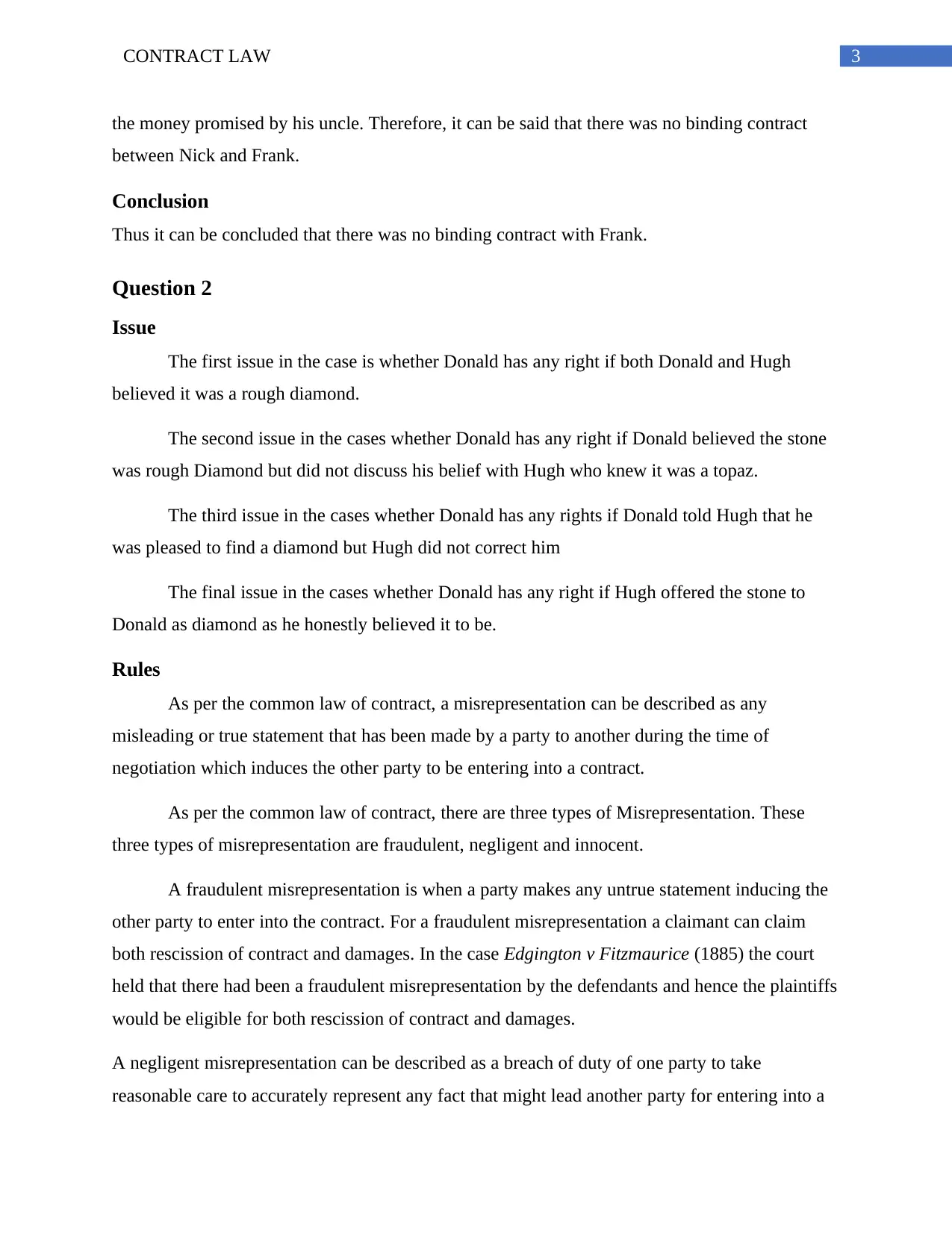
3CONTRACT LAW
the money promised by his uncle. Therefore, it can be said that there was no binding contract
between Nick and Frank.
Conclusion
Thus it can be concluded that there was no binding contract with Frank.
Question 2
Issue
The first issue in the case is whether Donald has any right if both Donald and Hugh
believed it was a rough diamond.
The second issue in the cases whether Donald has any right if Donald believed the stone
was rough Diamond but did not discuss his belief with Hugh who knew it was a topaz.
The third issue in the cases whether Donald has any rights if Donald told Hugh that he
was pleased to find a diamond but Hugh did not correct him
The final issue in the cases whether Donald has any right if Hugh offered the stone to
Donald as diamond as he honestly believed it to be.
Rules
As per the common law of contract, a misrepresentation can be described as any
misleading or true statement that has been made by a party to another during the time of
negotiation which induces the other party to be entering into a contract.
As per the common law of contract, there are three types of Misrepresentation. These
three types of misrepresentation are fraudulent, negligent and innocent.
A fraudulent misrepresentation is when a party makes any untrue statement inducing the
other party to enter into the contract. For a fraudulent misrepresentation a claimant can claim
both rescission of contract and damages. In the case Edgington v Fitzmaurice (1885) the court
held that there had been a fraudulent misrepresentation by the defendants and hence the plaintiffs
would be eligible for both rescission of contract and damages.
A negligent misrepresentation can be described as a breach of duty of one party to take
reasonable care to accurately represent any fact that might lead another party for entering into a
the money promised by his uncle. Therefore, it can be said that there was no binding contract
between Nick and Frank.
Conclusion
Thus it can be concluded that there was no binding contract with Frank.
Question 2
Issue
The first issue in the case is whether Donald has any right if both Donald and Hugh
believed it was a rough diamond.
The second issue in the cases whether Donald has any right if Donald believed the stone
was rough Diamond but did not discuss his belief with Hugh who knew it was a topaz.
The third issue in the cases whether Donald has any rights if Donald told Hugh that he
was pleased to find a diamond but Hugh did not correct him
The final issue in the cases whether Donald has any right if Hugh offered the stone to
Donald as diamond as he honestly believed it to be.
Rules
As per the common law of contract, a misrepresentation can be described as any
misleading or true statement that has been made by a party to another during the time of
negotiation which induces the other party to be entering into a contract.
As per the common law of contract, there are three types of Misrepresentation. These
three types of misrepresentation are fraudulent, negligent and innocent.
A fraudulent misrepresentation is when a party makes any untrue statement inducing the
other party to enter into the contract. For a fraudulent misrepresentation a claimant can claim
both rescission of contract and damages. In the case Edgington v Fitzmaurice (1885) the court
held that there had been a fraudulent misrepresentation by the defendants and hence the plaintiffs
would be eligible for both rescission of contract and damages.
A negligent misrepresentation can be described as a breach of duty of one party to take
reasonable care to accurately represent any fact that might lead another party for entering into a
Secure Best Marks with AI Grader
Need help grading? Try our AI Grader for instant feedback on your assignments.
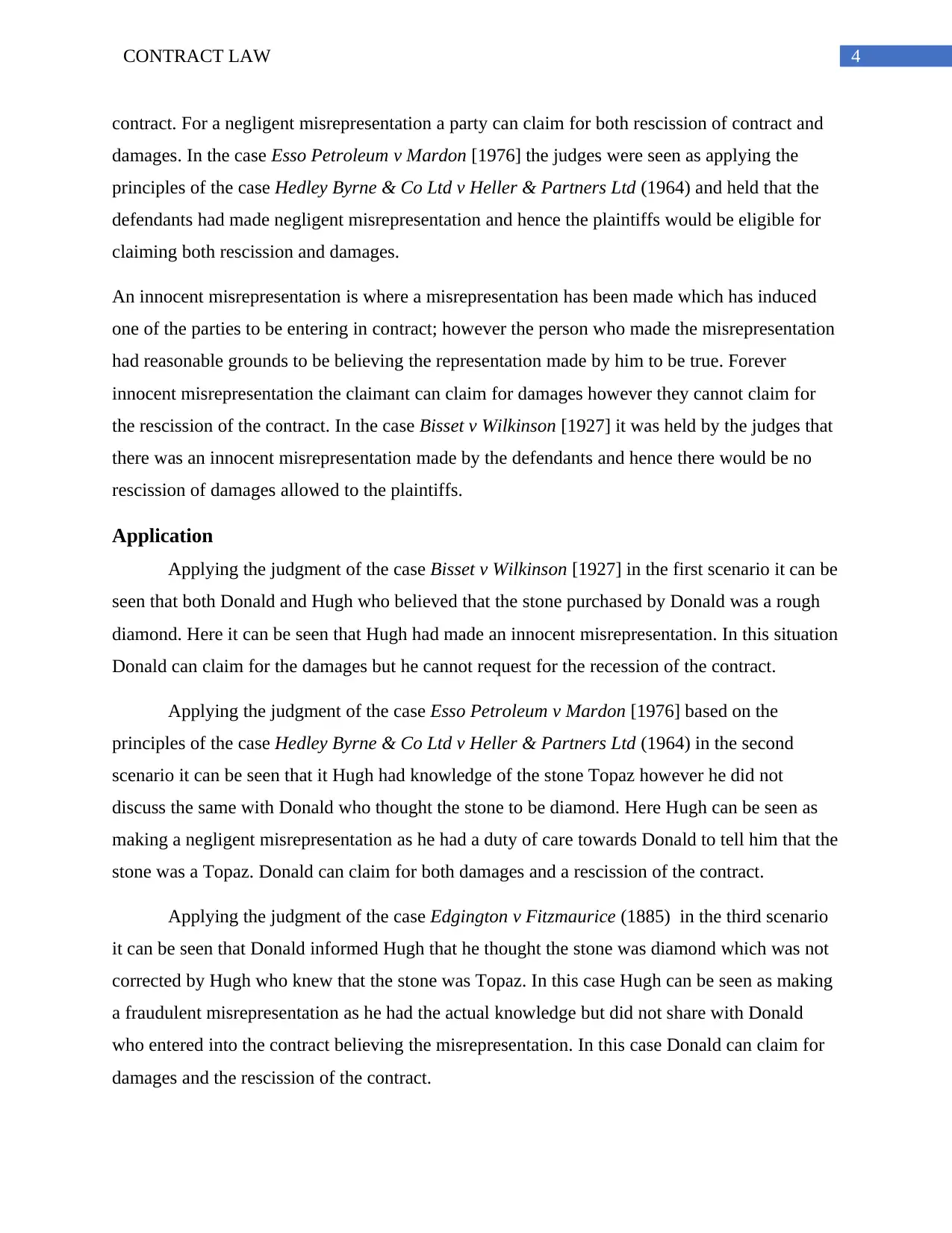
4CONTRACT LAW
contract. For a negligent misrepresentation a party can claim for both rescission of contract and
damages. In the case Esso Petroleum v Mardon [1976] the judges were seen as applying the
principles of the case Hedley Byrne & Co Ltd v Heller & Partners Ltd (1964) and held that the
defendants had made negligent misrepresentation and hence the plaintiffs would be eligible for
claiming both rescission and damages.
An innocent misrepresentation is where a misrepresentation has been made which has induced
one of the parties to be entering in contract; however the person who made the misrepresentation
had reasonable grounds to be believing the representation made by him to be true. Forever
innocent misrepresentation the claimant can claim for damages however they cannot claim for
the rescission of the contract. In the case Bisset v Wilkinson [1927] it was held by the judges that
there was an innocent misrepresentation made by the defendants and hence there would be no
rescission of damages allowed to the plaintiffs.
Application
Applying the judgment of the case Bisset v Wilkinson [1927] in the first scenario it can be
seen that both Donald and Hugh who believed that the stone purchased by Donald was a rough
diamond. Here it can be seen that Hugh had made an innocent misrepresentation. In this situation
Donald can claim for the damages but he cannot request for the recession of the contract.
Applying the judgment of the case Esso Petroleum v Mardon [1976] based on the
principles of the case Hedley Byrne & Co Ltd v Heller & Partners Ltd (1964) in the second
scenario it can be seen that it Hugh had knowledge of the stone Topaz however he did not
discuss the same with Donald who thought the stone to be diamond. Here Hugh can be seen as
making a negligent misrepresentation as he had a duty of care towards Donald to tell him that the
stone was a Topaz. Donald can claim for both damages and a rescission of the contract.
Applying the judgment of the case Edgington v Fitzmaurice (1885) in the third scenario
it can be seen that Donald informed Hugh that he thought the stone was diamond which was not
corrected by Hugh who knew that the stone was Topaz. In this case Hugh can be seen as making
a fraudulent misrepresentation as he had the actual knowledge but did not share with Donald
who entered into the contract believing the misrepresentation. In this case Donald can claim for
damages and the rescission of the contract.
contract. For a negligent misrepresentation a party can claim for both rescission of contract and
damages. In the case Esso Petroleum v Mardon [1976] the judges were seen as applying the
principles of the case Hedley Byrne & Co Ltd v Heller & Partners Ltd (1964) and held that the
defendants had made negligent misrepresentation and hence the plaintiffs would be eligible for
claiming both rescission and damages.
An innocent misrepresentation is where a misrepresentation has been made which has induced
one of the parties to be entering in contract; however the person who made the misrepresentation
had reasonable grounds to be believing the representation made by him to be true. Forever
innocent misrepresentation the claimant can claim for damages however they cannot claim for
the rescission of the contract. In the case Bisset v Wilkinson [1927] it was held by the judges that
there was an innocent misrepresentation made by the defendants and hence there would be no
rescission of damages allowed to the plaintiffs.
Application
Applying the judgment of the case Bisset v Wilkinson [1927] in the first scenario it can be
seen that both Donald and Hugh who believed that the stone purchased by Donald was a rough
diamond. Here it can be seen that Hugh had made an innocent misrepresentation. In this situation
Donald can claim for the damages but he cannot request for the recession of the contract.
Applying the judgment of the case Esso Petroleum v Mardon [1976] based on the
principles of the case Hedley Byrne & Co Ltd v Heller & Partners Ltd (1964) in the second
scenario it can be seen that it Hugh had knowledge of the stone Topaz however he did not
discuss the same with Donald who thought the stone to be diamond. Here Hugh can be seen as
making a negligent misrepresentation as he had a duty of care towards Donald to tell him that the
stone was a Topaz. Donald can claim for both damages and a rescission of the contract.
Applying the judgment of the case Edgington v Fitzmaurice (1885) in the third scenario
it can be seen that Donald informed Hugh that he thought the stone was diamond which was not
corrected by Hugh who knew that the stone was Topaz. In this case Hugh can be seen as making
a fraudulent misrepresentation as he had the actual knowledge but did not share with Donald
who entered into the contract believing the misrepresentation. In this case Donald can claim for
damages and the rescission of the contract.
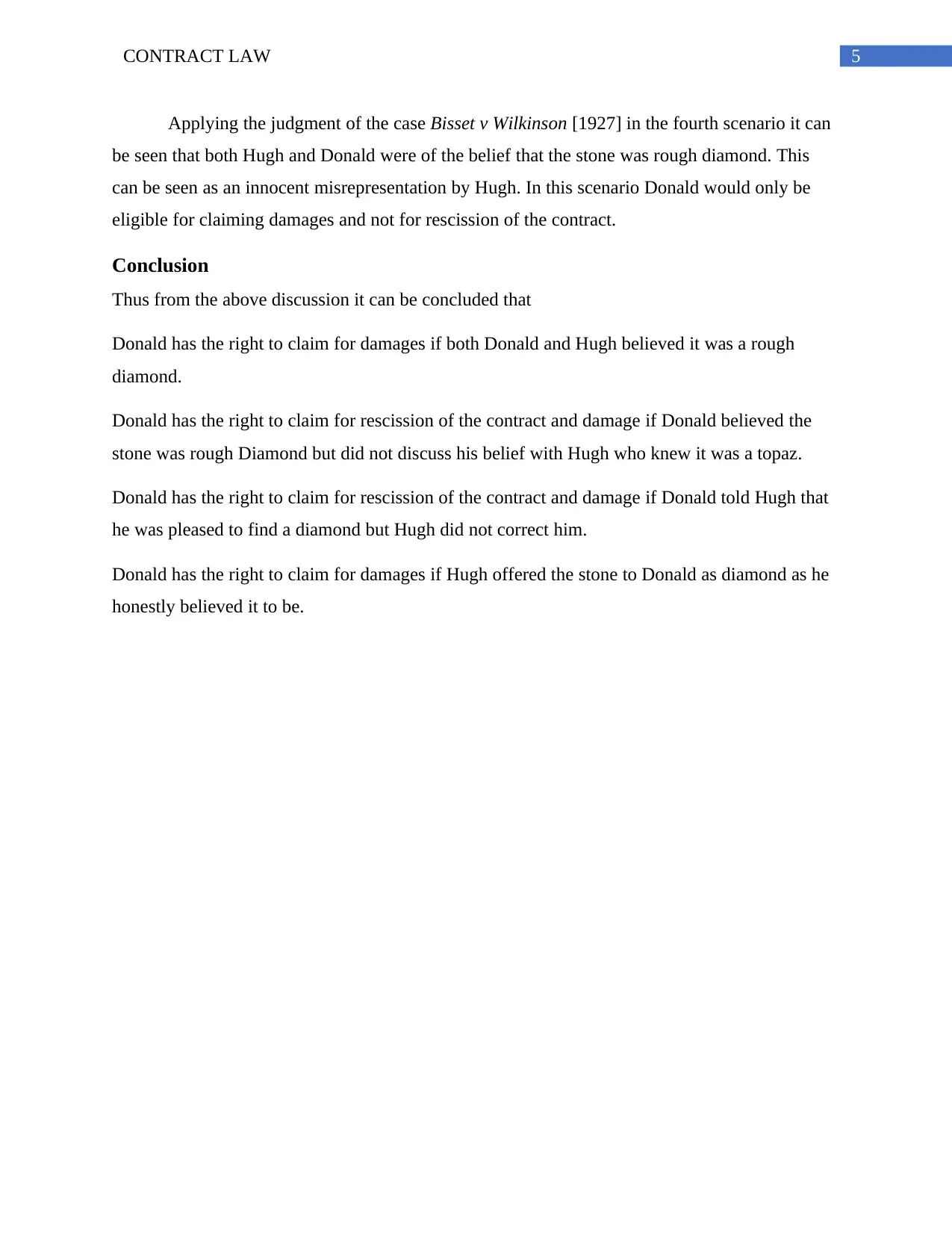
5CONTRACT LAW
Applying the judgment of the case Bisset v Wilkinson [1927] in the fourth scenario it can
be seen that both Hugh and Donald were of the belief that the stone was rough diamond. This
can be seen as an innocent misrepresentation by Hugh. In this scenario Donald would only be
eligible for claiming damages and not for rescission of the contract.
Conclusion
Thus from the above discussion it can be concluded that
Donald has the right to claim for damages if both Donald and Hugh believed it was a rough
diamond.
Donald has the right to claim for rescission of the contract and damage if Donald believed the
stone was rough Diamond but did not discuss his belief with Hugh who knew it was a topaz.
Donald has the right to claim for rescission of the contract and damage if Donald told Hugh that
he was pleased to find a diamond but Hugh did not correct him.
Donald has the right to claim for damages if Hugh offered the stone to Donald as diamond as he
honestly believed it to be.
Applying the judgment of the case Bisset v Wilkinson [1927] in the fourth scenario it can
be seen that both Hugh and Donald were of the belief that the stone was rough diamond. This
can be seen as an innocent misrepresentation by Hugh. In this scenario Donald would only be
eligible for claiming damages and not for rescission of the contract.
Conclusion
Thus from the above discussion it can be concluded that
Donald has the right to claim for damages if both Donald and Hugh believed it was a rough
diamond.
Donald has the right to claim for rescission of the contract and damage if Donald believed the
stone was rough Diamond but did not discuss his belief with Hugh who knew it was a topaz.
Donald has the right to claim for rescission of the contract and damage if Donald told Hugh that
he was pleased to find a diamond but Hugh did not correct him.
Donald has the right to claim for damages if Hugh offered the stone to Donald as diamond as he
honestly believed it to be.
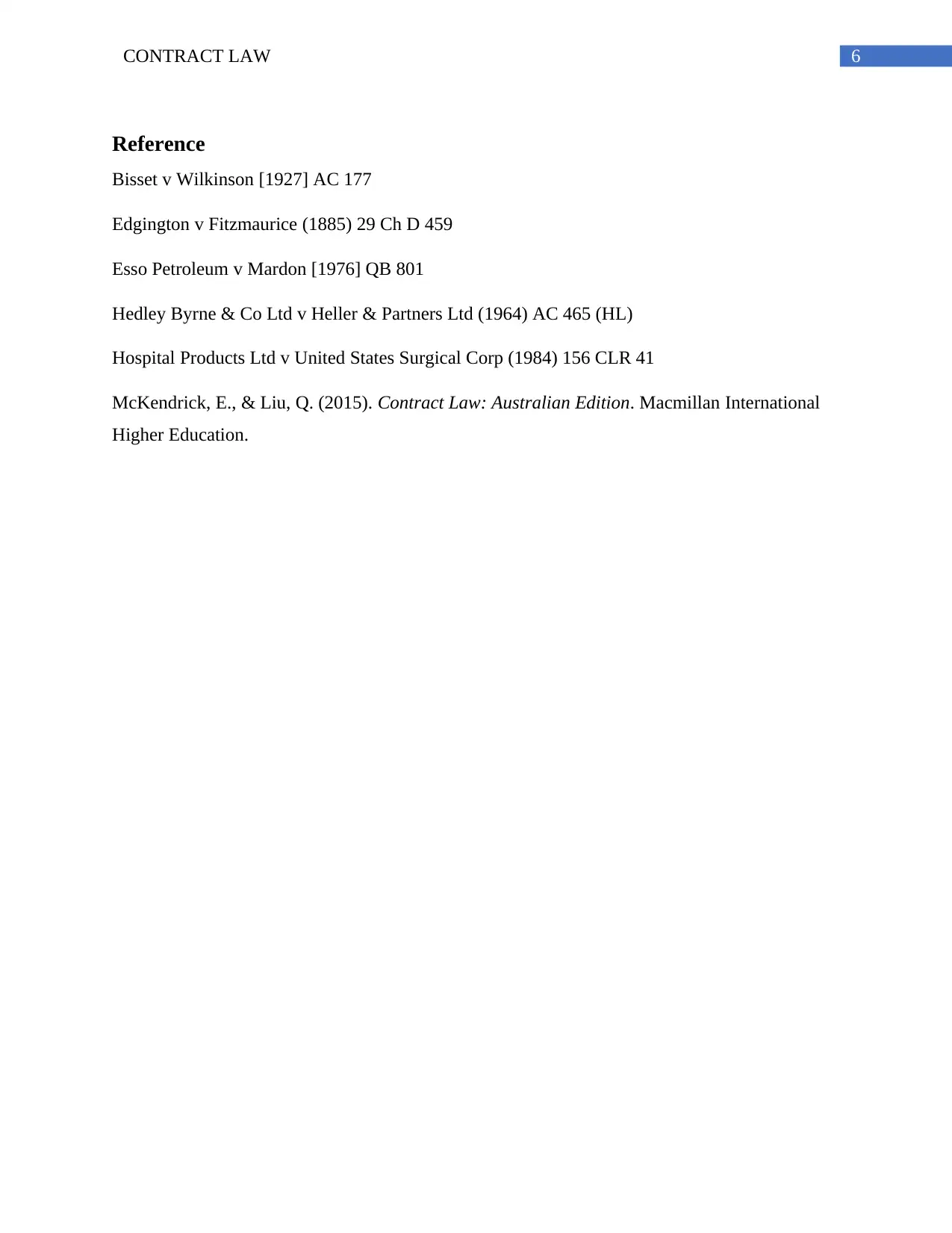
6CONTRACT LAW
Reference
Bisset v Wilkinson [1927] AC 177
Edgington v Fitzmaurice (1885) 29 Ch D 459
Esso Petroleum v Mardon [1976] QB 801
Hedley Byrne & Co Ltd v Heller & Partners Ltd (1964) AC 465 (HL)
Hospital Products Ltd v United States Surgical Corp (1984) 156 CLR 41
McKendrick, E., & Liu, Q. (2015). Contract Law: Australian Edition. Macmillan International
Higher Education.
Reference
Bisset v Wilkinson [1927] AC 177
Edgington v Fitzmaurice (1885) 29 Ch D 459
Esso Petroleum v Mardon [1976] QB 801
Hedley Byrne & Co Ltd v Heller & Partners Ltd (1964) AC 465 (HL)
Hospital Products Ltd v United States Surgical Corp (1984) 156 CLR 41
McKendrick, E., & Liu, Q. (2015). Contract Law: Australian Edition. Macmillan International
Higher Education.
1 out of 7
Related Documents
Your All-in-One AI-Powered Toolkit for Academic Success.
+13062052269
info@desklib.com
Available 24*7 on WhatsApp / Email
![[object Object]](/_next/static/media/star-bottom.7253800d.svg)
Unlock your academic potential
© 2024 | Zucol Services PVT LTD | All rights reserved.





